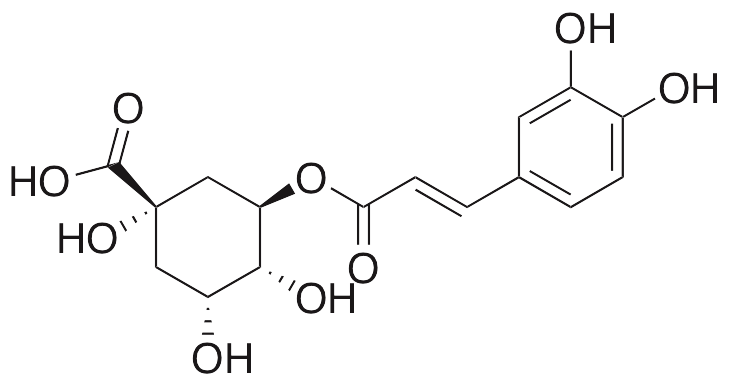服务热线
021-60498804
产品中心
/ Products Classification 点击展开+
| Cat. Number | C2944 |
| Chemical Name | C2944 CHLOROGENIC ACID (FROM LONICERA) 327-97-9 |
| CAS Number | 327-97-9 |
| Mol. Formula | C16H18O9 |
| Mol. Weight | 354.31 |
| Qty 1 |
100mg |
| Qty 2 | 1g |
| Appearance | Gray or white powder |
| Application Notes | ≥99% |
| Synonym | 3-Caffeoylquinic acid |
| Melting Pt. | 207-209°C(dec.) |
| Solubility | Soluble in ethanol or acetone. |
| Storage condition | Ambient |
| References | Chlorogenic acid is a polyphenol derivative of caffeic acid found in Lonicera that exhibits a wide variety of beneficial properties, including antibacterial, antioxidative, anti-inflammatory, hepatoprotective, neuroprotective, anti-allergic, anticancer chemotherapeutic, and chemopreventive activities. Chlorogenic acid alters membrane stability of bacteria such as Staphylococcus, and may also inhibit pepsin activity. Chlorogenic acid also prevents acetaminophen-induced liver injury, preventing activation of caspases 3 and 7 as well as phosphorylation of ERK1/2, JNK, and p38 MAPK; it also increases levels of glutathione and thioredoxin and increases activity of glutathione reductase and thioredoxin reductase, preventing oxidative stress and apoptosis in vitro. In similar in vivo models, chlorogenic acid prevents activation of NF-κB and decreases expression of toll-like receptor 4 (TLR4), myd88, iNOS, COX-2, TNF-α, IL-6, and IL-1β. This compound decreases histamine release and inhibits mast cell activation, preventing systemic anaphylaxis. In vitro, chlorogenic acid inhibits dopamine oxidation and interactions between dopamine and α-synuclein, indicating potential benefit in the treatment of Parkinson’s disease. Additionally, this compound inhibits DNA methyltransferase (DNMT) in a non-competitive manner and also inhibits glucose-6-phosphate translocase, decreasing expression of matrix metalloproteinase 2 (MMP2) and inhibiting glioma cell migration. ReferencesZeng HJ, Liang HL, You J, et al. Study on the binding of chlorogenic acid to pepsin by spectral and molecular docking. Luminescence. 2013 Dec 12. [Epub ahead of print]. PMID: 24339327. Luís A, Silva F, Sousa S, et al. Antistaphylococcal and biofilm inhibitory activities of gallic, caffeic, and chlorogenic acids. Biofouling. 2014 Jan;30(1):69-79. PMID: 24228999. Shi H, Dong L, Jiang J, et al. Chlorogenic acid reduces liver inflammation and fibrosis through inhibition of toll-like receptor 4 signaling pathway. Toxicology. 2013 Jan 7;303:107-14. PMID: 23146752. Teraoka M, Nakaso K, Kusumoto C, et al. Cytoprotective effect of chlorogenic acid against α-synuclein-related toxicity in catecholaminergic PC12 cells. J Clin Biochem Nutr. 2012 Sep;51(2):122-7. PMID: 22962530. Lou Z, Wang H, Zhu S, et al. Antibacterial activity and mechanism of action of chlorogenic acid. J Food Sci. 2011 Aug;76(6):M398-403. PMID: 22417510. Qin HD, Shi YQ, Liu ZH, et al. Effect of chlorogenic acid on mast cell-dependent anaphylactic reaction. Int Immunopharmacol. 2010 Sep;10(9):1135-41. PMID: 20620227. Belkaid A, Currie JC, Desgagnés J, et al. The chemopreventive properties of chlorogenic acid reveal a potential new role for the microsomal glucose-6-phosphate translocase in brain tumor progression. Cancer Cell Int. 2006 Mar 27;6:7. PMID: 16566826. Lee WJ, Zhu BT. Inhibition of DNA methylation by caffeic acid and chlorogenic acid, two common catechol-containing coffee polyphenols. |





